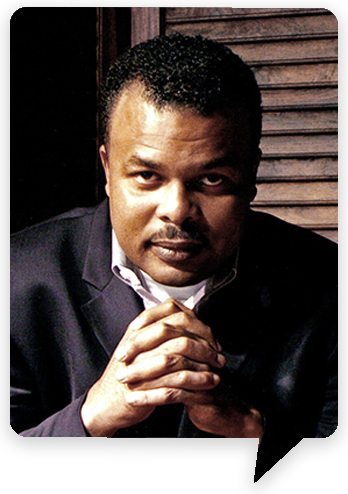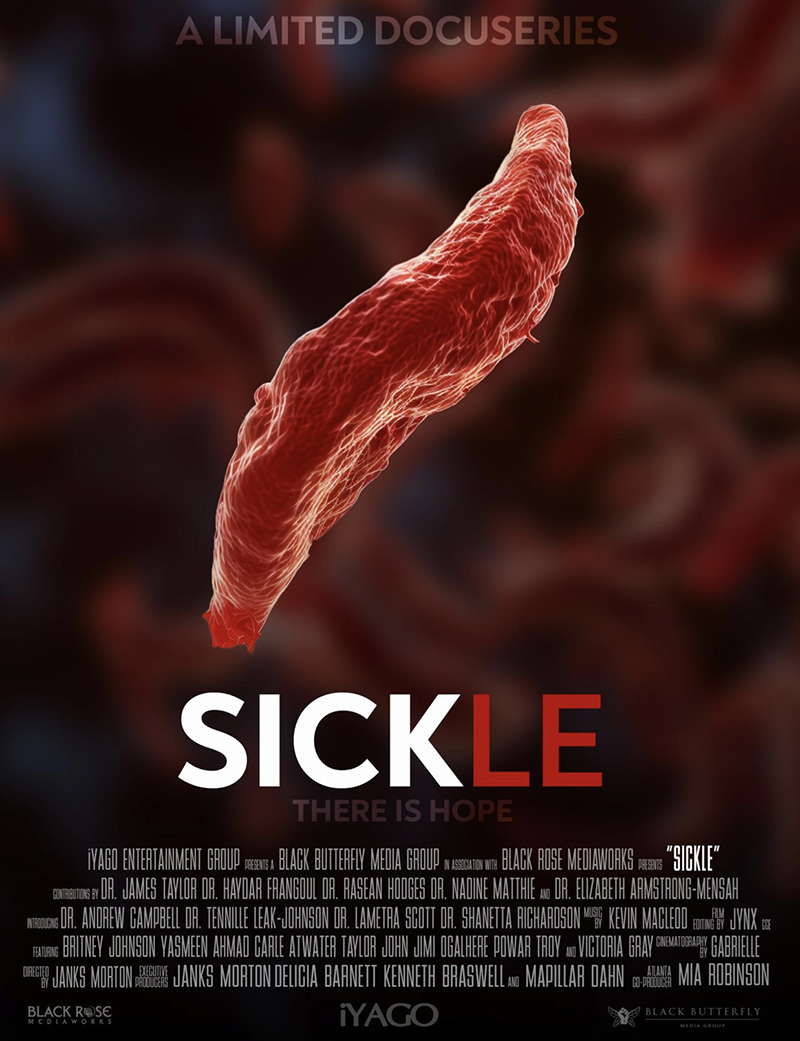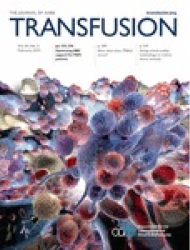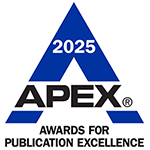“This is just the beginning. I’m just honored to witness history, up close, through the lens.” - Janks Morton

This month’s “In Conversation” interview features filmmaker Janks Morton and his latest project, SICKLE, an emotional and inspiring docuseries that shines a spotlight on sickle cell warriors. Morton, whose body of work focuses on critical issues impacting African American communities, set out to raise awareness about sickle cell disease (SCD) and amplify unheard voices. Through thought-provoking and raw conversations, the multi-episode project aims to capture each warrior’s personal journey and the obstacles they endure while navigating the often-overlooked disease.
SICKLE follows the journey of multiple individuals with SCD, and spotlights both gene therapy recipients and bone marrow recipients. In addition, the series features researchers and health care professionals from the blood and biotherapies community, including those at the forefront of gene therapy.
Morton spoke with AABB News about his inspiration behind the project, his passion to change the narrative around SCD and the critical role of transfusion medicine in the treatment of SCD.
It actually started with a text message. A member of a community-based organization working in association with Howard University reached out, asking if I’d heard about the “cure” for sickle cell—or gene therapy. I hadn’t. But once I had the chance to dig in, I was stunned. I knew right then a documentary could help make sense of all the layers—the treatment, blood donation, stigma history—for a wider audience. That was in January 2024. Other projects kept me busy until October.
Then, something happened that really cemented it for me. I was at a fellow filmmaker’s home, talking through the concept of SICKLE, and he said, “I think Will—my son’s best friend—has that.” So, I invited Will in, handed him a one-pager I’d written up for the docuseries, and asked if he knew about gene therapy. He got emotional and told me he didn’t have full SCD, just the trait—but he still experienced pain crises about once a year. That blew my mind. I didn’t even know that was possible with just the trait.
And then he broke down. Through his tears, he told me his mother had SCD and had lost her vision 20 years earlier. He was her primary caregiver. I asked him why he was crying, and he said something I’ll never forget: “Because I’ve never had hope.”
That was it for me. I shot my first interviews about a week later, and I have not stopped since.

Fighting back tears—sometimes unsuccessfully—as warriors opened up about their mistreatment, neglect, mismanagement, and what it feels like to move through the world unheard, unseen and unacknowledged. You sit across from someone who’s spent their whole life in and out of hospitals, who knows pain on a cellular level, and they’re telling you about being dismissed, misdiagnosed or labeled as drug-seeking. That stuff hits you. And it should.
But the most rewarding part? It’s those same warriors, sometimes mid-interview or right after filming, telling you: “Thank you for seeing me.” That’s it right there. That’s the moment. That’s the reason to keep going, camera in hand. To make sure they’re not invisible anymore. And then I go to my car... and cry a little more.
The hardest part for me was trying to contain my excitement around gene therapy. Coming in, I had no real experience with the sickle cell community. I didn’t yet understand the layers—the pain, the generational trauma, the dashed hopes from past failed therapies—and so I came in a little too wide-eyed.
One of the warriors grounded me early on. I asked her about gene therapy, and she said flatly: “It ain’t for me. I ain’t nobody’s guinea pig.” That moment shook me. I walked away confused and honestly disappointed. But as the months passed and I sat down with more than 60 warriors, researchers, caregivers and clinicians, I started to get it. I learned how deep the skepticism runs—and why. And with that, I’ve developed a more measured approach to how I talk about what I’ve seen.
Because what I’ve seen has been miraculous. Watching people who’ve undergone treatment with Casgevy, Lyfgenia and BEAM-101—watching them transform, watching their labs improve, watching hope return—it’s profound. But even in that excitement, I stay grounded by voices like Dr. Haydar Frangoul, who’s led more than 50 gene therapy treatments. He told me, “This is just the first step.”
And he’s right. This is just the beginning. I’m just honored to witness history, up close, through the lens.
One of the most pressing issues in the sickle cell community is the significant gap between the need for blood transfusions and the availability of compatible blood, particularly from African American donors. SCD predominantly affects individuals of African descent; approximately 1 in 365 African American babies are born with the disease, and about 1 in 13 carry the sickle cell trait.
Despite this, blood donation rates among African Americans are disproportionately low. Only about 0.6% of the Black population donates blood, compared with 1.1% of the white population. This disparity creates a significant challenge in providing antigen-matched blood for patients with SCD, who often require regular transfusions to manage their condition.
Many people are unaware of the complexities involved in transfusion medicine. Ask the average person about the personnel or equipment used in the transfusion process, and they likely have little to no idea. By showcasing the transfusion process in the docuseries and featuring interviews with the specialists who perform these life-saving procedures, we aim to demystify the process and highlight its critical role in the treatment of SCD.
Our goal is to educate viewers on the importance of blood donations, especially from African American donors, and to foster a deeper understanding of the challenges faced by those living with SCD. By bringing these stories to light, we hope to inspire more people to donate blood and support the sickle cell community.
I’m literally sitting in my office right now after visiting one of the warriors in the hospital this morning. She and I were supposed to co-host a women-only roundtable this weekend in Columbus, Ga.—about 90 miles from me—focused on the unique challenges women with SCD face.
This morning, I woke up to a text from her: “Hey, I’m at Grady in crisis, but I’m pushing through. We might have to reschedule this weekend, if that’s okay with you.”
Now, let me break that down. This woman drove 90 miles—by herself—in what she described as a 7 out of 10 on the pain scale, because anything higher, “I wouldn’t have been able to drive.” And she’s asking me if it’s okay to reschedule.
I filmed her this morning, right there in the hospital bed. She was calmly explaining how her endometriosis, coupled with her monthly cycle, triggers a pain crisis practically every month—like clockwork. She described the avascular necrosis in both hips, how her bones grind, how the meds prescribed are just trying to slow down the damage. And she was smiling, with a glow in her heart, as she described all of this, as if everything is okay.
The mental, emotional, spiritual and physical stamina these patients carry is honestly humbling. But that same resilience creates a dangerous misconception—because they don’t always look like they’re in pain, unlike some conditions that are recognizable.
With the advancements in curative therapies, I truly believe the toll SCD takes on warriors may finally be coming to an end. But we have to understand how deep the neglect has gone. In 1979, the median age of death for adults with SCD was 42. In 2017—almost 40 years later—it was still 42 (Chaturvedi S, et al., Am J Hematol, 2018). That kind of stagnation reinforces the feeling many in the community already carry: that no one really cares.
But now, I believe these early breakthroughs in gene therapy are the game-changers the community has been waiting for. Yes, there are challenges with cost, Medicaid access and misinformation. But this is where independent voices, especially outside the traditional medical space, can help shift the narrative. We need to raise awareness about this miracle.
Since 2006, every U.S. state and D.C. has mandated universal newborn screening for the sickle cell trait. So technically, this next generation should already know their trait status. But they don’t. Too many young people, especially African Americans, still have no idea if they carry the trait.
That’s why we’re launching the K.Y.S.S. campaign: Know Your Sickle Status. We're hoping to officially launch it this September during World Sickle Cell Awareness Month. Think of it like the HIV awareness push in the ’90s—straightforward, memorable and impactful. The data is sobering: 97% of couples who have a child with SCD did not know their trait status beforehand.
If we can change that through awareness, testing and these new treatment options, then a generation from now, SCD won’t be a crisis. It’ll be a conversation in the rearview mirror.
Start by asking one question: Do you know your sickle cell trait status? If not, find out. Then, donate blood, especially if you’re Black. That blood can be the difference between a crisis and a cure. And lastly, share the series. The more eyes we get on this, the more lives we touch.
BACK TO ISSUE
June 2025
Transfusion is AABB’s scholarly, peer-reviewed monthly journal, publishing the latest on technological advances, clinical research and controversial issues related to transfusion medicine, blood banking, biotherapies and tissue transplantation. Access of Transfusion is free to all AABB members.
Learn More About Transfusion Journal
Keep abreast of what's happening in the field of biotherapies with CellSource - AABB's monthly update on the latest biotherapies news.
To submit news about the blood and biotherapies field to AABB, please email news@aabb.org.
President
Meghan Delaney, DO, MPH
Chief Executive Officer
Debra Ben Avram, FASAE, CAE
Chief Communications and Engagement Officer
Julia Zimmerman
Director of Marketing and Communications
Jay Lewis, MPH
Managing Editor
Kendra Y. Mims, MFA
Senior Communications Manager
Drew Case
AABB News
(ISSN 1523939X) is published monthly, except for the combined November/December issue for the members of AABB; 4550 Montgomery Avenue; Suite 700 North Tower; Bethesda, MD 20814.
AABB is an international, not-for-profit association representing individuals and institutions involved in transfusion medicine, cellular therapies and patient blood management. The association is committed to improving health by developing and delivering standards, accreditation and educational programs that focus on optimizing patient and donor care and safety.
+1.301.907.6977
Email: news@aabb.org
Website: www.aabb.org
Copyright 2025 by AABB.
Views and opinions expressed in AABB News are not necessarily endorsed by AABB unless expressly stated.
Notice to Copiers: Reproduction in whole or part is strictly prohibited unless written permission has been granted by the publisher. AABB members need not obtain prior permission if proper credit is given.
